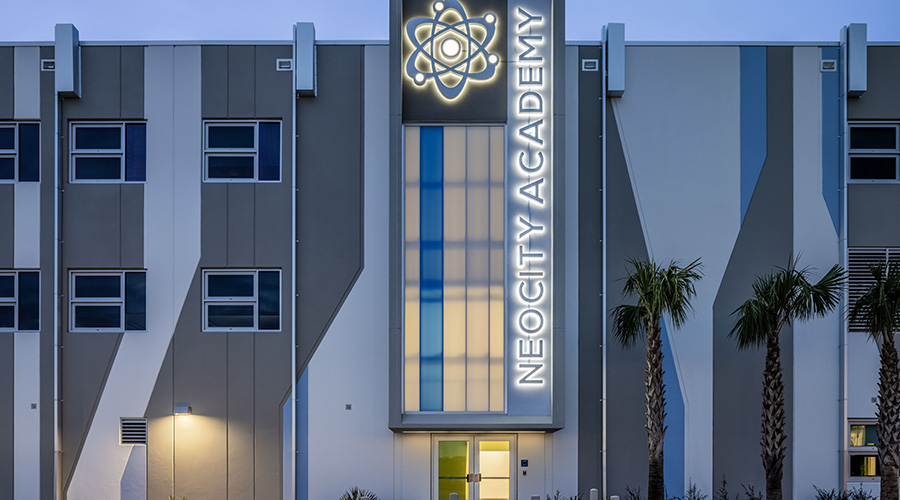A Look Behind the Curtain at WELL, Fitwel, and LEED
A recent office project shows how sustainability and health and wellness complement each other
By Garrett Ferguson and Ruth Vandruff
When the decision was made to simultaneously pursue LEED, WELL, and FitWel certifications for the new Perkins and Will Dallas office, there were a number of unknowns. Each rating system has different goals, some of which overlap. Other elements of the rating systems tend to contradict each other. Still, in the design of this new workplace within the Old Dallas High School each rating system has had its own unique impact on building occupants.
The office has been broken into pods, or groups of 12-24 desks. The original walls of the high school and the classrooms therein naturally lend toward smaller group settings. Common spaces are centralized, including large gathering spaces, break areas, and conference rooms. The Dallas office currently has just under 250 employees.
High Air Quality
LEED and WELL both take significant deep dives into environmental quality. Multiple efforts were implemented to ensure high indoor air quality as a result: higher than normal MERV 13 filtration, an indoor air quality management plan implemented during construction, and multiple other design strategies. An unanticipated plus has been the noticeability of dust on the lighter colored desks, which were encouraged in order to perfect lighting distribution across the personal workspace area. While this dust is a bit of a visual nuisance, it would have likely gone unnoticed for years if not for the white desks, improving the indoor air quality through higher visibility that allows an opportunity for a deeper clean.
Nobody was expecting the impact of implementing new strategies around trash cans. WELL asked that trash cans either be enclosed in cabinetry or have lids. Medium- and small-sized trash cans needed to have lids and be hands-free. If it’s desired to have a desk-side recycling bin without a lid, the bin can be available for paper collection only. With the requirement in LEED to implement recycling, there was a need to balance the recycling plan with the requirements from WELL. Personal hands-free trash cans with lids were found, but were significantly pricier than typical desk-side trash cans. Additionally, the office would need two for each person to facilitate both recycling and garbage collection, doubling that cost another time. With such efforts being so expensive, the design team was instructed to find a different solution.
Ultimately, each pod now has two to three medium sized trash cans each, shared by the pod collectively. These have a foot pedal to make them hands free and have internal dividers to separate commingled recycling and garbage. Color coded bags indicated recycling and garbage. Composting has even been introduced in the common areas. While concerns were raised regarding the culture shift in requiring people to get up to throw their trash away, the air quality impact was surprising. WELL’s intent on this feature is to reduce smells and pests, and it worked! There was a noticeable decline in leftover lunch smells and pests in general.
Access to Water
Each of the three rating systems has different goals around the idea of water, but each system’s approach has valid points. LEED takes a focus on reducing the amount of water used and wasted—an important and simple strategy that has been proven effective. WELL and FitWel focus on occupant health, but WELL has a special focus on providing high quality water to building occupants. Both certification programs take a strong interest in making water easily accessible to everyone in the building.
To achieve these strategies, a point-of-source Reverse Osmosis system was implemented at each break room and in the mother’s lounge. The filtration system also includes a UV light to disinfect the water, as well as a filter that would remineralize the water, introducing trace minerals back into the water for taste. A post-occupancy evaluation showed that 95.1 percent of building occupants enjoyed the water in the office, compared to 77.8 percent of occupants at the previous office location. It should also be noted that the old location offered filtered water, but not to such a large degree. Continued maintenance has been required to keep the systems running correctly, particularly when the water systems provide filtered water to other equipment such as ice dispensers and coffee makers.
The desire for accessibility from both WELL and FitWel requirements posed a few challenges. One of the credits asked that water stations be available within 100 feet of all occupants in the space. That wasn’t an issue for most spaces, but there were two remote areas that didn’t fall within that threshold. Introducing plumbing into those areas was too costly, but an alternative compliance path allows a water dispenser to be located in those areas if refilled daily –– ultimately allowing a path to navigate around this challenge. Though convenient, few people tend to use the dispensers. Employees were either unsure of the frequency the stations were refilled or preferred to walk to the break areas in order to stretch their legs.
Space Types
Beyond the open workspace areas, and in support of achieving several WELL optimizations, spaces were designed for group exercise, as well as individual quiet time and privacy.
For exercise, a large multipurpse room was designed to function as a flexible space. It was furnished with wheeled, foldable tables and stackable chairs that could be easily moved aside when the room was repurposed from a meeting or conference setup to a fitness space. Large monitors were placed on two walls for streaming of online fitness classes. Due to its size and the multitude of configuration options available, the space proved to be very popular and was consistently booked for meetings. One important lesson learned was that these high-traffic, flexible spaces are prone to some wear and tear due to the shifting of furniture, and special care must be taken with the selection of products that can withstand constant handling.
To offer support and privacy for nursing mothers in the building, a small room was equipped with a sink, filtered water, mini refrigerator, and a comfortable recliner. For this type of space to function as intended, it would ideally have a door lock equipped with a visual indicator that clearly shows the room status as occupied or vacant. It’s also helpful to communicate a method for reserving the space for use, a lesson learned from the high demand for the room.
Again, to tie in with WELL optimizations, both a nap room and focus room were offered to building occupants as a retreat from the open office hustle. For healthy sleep support, a “quiet room” was designed with a couch, a privacy curtain, and no technological additions. Similarly, two focus rooms offer a small enclosed space for “heads-down” work or private phone calls. The primary challenge with these spaces is ensuring that they are being used as intended. In both cases, these rooms are tempting places to hide or store items out of sight, compromising their use as an effective getaway.
Office-Wide Nutrition
Both WELL and FitWel have requirements regarding food available in the office. It’s understood that all-encompassing wellness requires proper nutrition but implementing said strategies at an office level has proven more difficult than initially expected. Not only were the food vendors unwilling to vet their catalogs to cull cuisine that didn’t comply, but the implementation of the standards has required an administrative supervision of the in-office vending to ensure compliance is still achieved.
The requirement to provide alternative food choices to anyone with allergies and/or special diets has also added a new layer of complexity. When providing working lunches with large simultaneous meetings, careful attention to detail is required. Balancing multiple allergies and diets (gluten, vegan, dairy, etc.) at the same time has mandated some formality to reduce the number of needs to a manageable level, particularly noting when someone makes a personal choice to implement a new diet into their lifestyle. Such changes now require a discussion with HR to formally be put on a list for special dietary needs. Still, with an office of this size, a significant effort must be made to coordinate office-provided lunches, with WELL and FitWel’s requirements elevating the need for organization.
Walkability and Site Safety
The building is located on the edge of a downtown area that is still undergoing revitalization, so it was a priority to ensure that occupants felt safe to walk to and from transportation hubs and surrounding areas. In cases such as this, it’s a good idea to work with the local police department to increase their visibility in the area. Additionally, you might contact other local community organizations with offers to use building space for their meetings along with a means to inform occupants of area amenities and opportunities. This process will assist with earning credits in all three certification types.
Material Impacts
Creating a space with a focus on healthy materials is emphasized in both LEED and WELL certifications. For example, stain repellents used to treat fabric furniture components are highly discouraged as they often contain potentially toxic ingredients. It was determined that a regular cleaning schedule would be a necessity in high-use areas within the office. Finding a vendor for commercial fabric cleaning can be a bit of a challenge, but it’s helpful to take bids for a guaranteed number of pieces to be cleaned on a quarterly or semi-annual basis. It’s important to keep in mind that this work will usually need to be performed outside of normal office hours to allow for dry time.
Each of the three rating systems pursued in this office have their own nuances, requirements, and needed strategies. While many elements overlap, there are a number that require special attention. The ultimate question is: do these rating systems make a difference, enough so that the extra coordination to ensure their compliance is worth the effort? Through our research and personal experience, the answer is yes.
When asked if occupants believe the office supports their overall health and well-being, the positive responses nearly tripled, from 28 to 79 percent. Nearly everyone prefers having a sit-stand desk, and overall stress has decreased as a result of the wellness efforts. In a new world where global pandemics have the power to slow the entire planet to a near halt, having cleaning and sanitizing plans and an emphasis on health already in place makes things easier—not harder.
“Sure,” you say, “but we can do that without going after the certifications and save lots of money!” While that may appear to be true, rating systems keep people invested. When the goal is to achieve a certain level of certification, there’s a minimum amount of effort required to attain that threshold. When the desire is only to “design to” the standard, the tendency is for strategies to drop off the project. When a holistic approach is taken and a hard line is set on a desired outcome, overall impacts improve significantly, and are carried through to the end. The result in this case is a space filled with people who feel healthier than they did a few years prior, only a few miles down the road.
Garrett Ferguson is sustainable building advisor and associate at design firm Perkins and Will's Dallas office. Ruth Vandruff is senior associate and office manager for Perkins and Will's Dallas office.
Related Topics:












